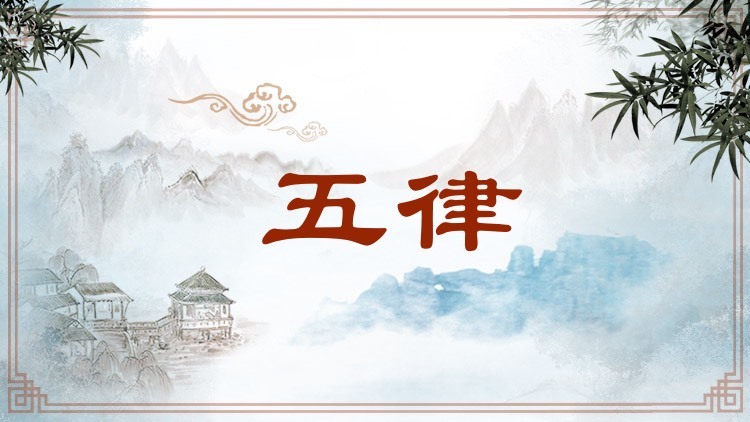Five-character Rhythmic Poetry

五言律诗,是中国古代律诗的重要体式之一。其基本形式为八句四韵,每句五个字。六韵、八韵乃至更多韵的五言长律,也属于五律。五律的写作有音律和修辞两方面的要求。音律体现为平仄声调和押韵。五律约有四种基本句式,平仄交错,按照黏对规则安排字句,在偶数句押韵,一般押平声韵。修辞体现在对仗和起承转合的章法上,八句分首、颔、颈、尾四联,中间的颔、颈两联对仗。五律是五言诗中最精密的形态,将音律之美和修辞之美融合在一起,整体节奏流畅、兴象浑融,具有中正平和的艺术审美效果。唐朝的五律成就最高,名家辈出,佳作如林。另外,从唐代至清代,六韵或八韵的五律一直是科举考试的必考项目,被称作试帖诗。这也充分证明了五律在中国古典文化中的重要性。
Five-character rhythmic poetry is one of the most important forms of ancient Chinese rhyming poetry. The basic form is eight lines with four pairs of rhymes and each line has five characters. Long rhyming poems with six, eight or even more rhymes are also part of five-character rhythmic poetry. Five-character rhythmic poetry must meet both metrical rules and rhetorical requirements. The metrical rules refer to level and oblique tones and the rhyme scheme. In five-character rhythmic poetry, there are four basic types of lines, alternating between level and oblique tones; level and oblique tones must match between different pairs of lines and within the same pair of lines; and rhymes are in even numbered lines, usually with the level tone. The rhetoric is embodied in the antithesis and the arrangement of introduction, elucidation, transition and summing up. The eight lines are divided into the first, second, third, and fourth pairs, and the second and third pairs in the middle are antithetical. Five-character rhythmic poetry is the most sophisticated form of Chinese five-character poetry, combining the beauty of temperament and rhetoric. The overall rhythm is smooth, and impromptu inspirations and material objects are integrated, producing the artistic aesthetic effect of tranquility and stateliness.
The Tang Dynasty attained the greatest achievement in five-character rhythmic poetry, with a large number of famous poets and poems. In addition, from the Tang Dynasty to the Qing Dynasty, five-character rhythmic poetry with six or eight rhymes, known as shitie poetry (试帖诗), was always a compulsory item in the imperial examination. This fully illustrates the importance of this type of poetry in classical Chinese culture.
引例 Citation:
◎五言律体,极盛于唐。要其大端,亦有二格:陈、杜、沈、宋,典丽精工;王、孟、储、韦,清空闲远,此其概也。(胡应麟《诗薮·内编四》)
五言律诗,在唐代达到极盛。总结其主要特点,有两种风格:陈子昂、杜审言、沈佺期、宋之问的诗,典雅、华丽、精致、工稳;王维、孟浩然、储光羲、韦应物的诗,清新、空灵、悠闲、高远。这是唐代五律的大致情况。
Five-character rhythmic poetry reached its peak in the Tang Dynasty. To summarize its main features, there were two styles. The poems of Chen Zi'ang, Du Shenyan, Shen Quanqi, and Song Zhiwen were elegant, sumptuous, refined, and pertinent; the poems of Wang Wei, Meng Haoran, Chu Guangxi, and Wei Yingwu were fresh, graceful, relaxed, and lofty. Such is the general situation of the five-character rhythmic poetry of the Tang Dynasty. (Hu Yinglin: An In-depth Exploration of Poetry)
推荐:教育部 国家语委
供稿:北京外国语大学 外语教学与研究出版社
责任编辑:钱耐安





